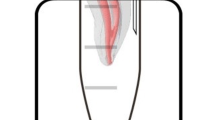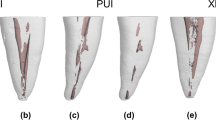Abstract
Objectives
Sealer remnants in the access cavity may negatively affect coronal seal and cause tooth discoloration. This study sought to evaluate the efficacy of different cleaning protocols for the sealer-contaminated access cavity.
Materials and methods
Sixty extracted human molars were accessed, chemomechanically prepared and warm vertically obturated with gutta-percha and epoxy resin sealer. Teeth were randomly assigned to one control (air/water spray) and five test groups (n = 10): scrubbing with an ethanol-saturated cotton pellet (CP), scrubbing with an ethanol-saturated microbrush (MB), air polishing (ProphyFlex, KaVo), MB + air polishing and cleaning with a round bur. Each tooth was split sagittally, and the sealer-covered access cavity area (SCA) before and after cleaning was determined using image analysis software and compared pre- and post-operatively and across groups using paired samples t test and one-way ANOVA.
Results
The SCA was significantly reduced in all test groups (P < 0.05), but not in the control group (P > 0.05). Highest epoxy resin sealer reductions were observed for MB (92%) and MB + air polishing (94%), yielding a significantly better SCA reduction than that of ethanol-saturated cotton pellet (58%), bur cleaning (69%) or air polishing alone (64%).
Conclusions
All cleaning protocols except air/water spray reduced the amount of epoxy resin sealer in the access cavity, but none of them completely removed the sealer. Cleaning with the ethanol-saturated microbrush, with or without air polishing, performed better than the other methods.
Clinical relevance
Scrubbing with an ethanol-saturated microbrush, with or without air polishing, was the most efficient method for cleaning the epoxy resin sealer-contaminated molar access cavity.


Similar content being viewed by others
References
Gutmann JL, Witherspoon DE (2002) Obturation of the cleaned and shaped root canal system. In: Cohen S, Burns RC (eds) Pathways of the pulp. Mosby, St. Louis
Hata G, Kawazoe S, Toda T, Weine FS (1992) Sealing ability of Thermafil with and without sealer. J Endod 18:322–326
Saleh IM, Ruyter IE, Haapasalo MP, Orstavik D (2003) Adhesion of endodontic sealers: scanning electron microscopy and energy dispersive spectroscopy. J Endod 29:595–601. https://doi.org/10.1097/00004770-200309000-00013
Ahmed HM, Abbott PV (2012) Discolouration potential of endodontic procedures and materials: a review. Int Endod J 45:883–897. https://doi.org/10.1111/j.1365-2591.2012.02071.x
Meincke DK, Prado M, Gomes BP, Bona AD, Sousa EL (2013) Effect of endodontic sealers on tooth color. J Dent 41(Suppl 3):e93–e96. https://doi.org/10.1016/j.jdent.2012.10.011
Križnar I, Zanini F, Fidler A (2019) Presentation of gaps around endodontic access cavity restoration by phase contrast-enhanced micro-CT. Clin Oral Invest 23:2371–2381. https://doi.org/10.1007/s00784-018-2680-y
Wu MK, Wesselink PR (1993) Endodontic leakage studies reconsidered. Part I. Methodology, application and relevance. Int Endod J 26:37–43
Leonard JE, Gutmann JL, Guo IY (1996) Apical and coronal seal of roots obturated with a dentine bonding agent and resin. Int Endod J 29:76–83. https://doi.org/10.1111/j.1365-2591.1996.tb01165.x
Gillen BM, Looney SW, Gu LS, Loushine BA, Weller RN, Loushine RJ, Pashley DH, Tay FR (2011) Impact of the quality of coronal restoration versus the quality of root canal fillings on success of root canal treatment: a systematic review and meta-analysis. J Endod 37:895–902. https://doi.org/10.1016/j.joen.2011.04.002
Bohrer TC, Fontana PE, Wandscher VF, Morari VHC, Dos Santos SS, Valandro LF, Kaize OB (2018) Endodontic sealers affect the bond strength of fiber posts and the degree of conversion of two resin cements. J Adhes Dent 20:165–172. https://doi.org/10.3290/j.jad.a40301
Roberts S, Kim JR, Gu LS, Kim YK, Mitchell QM, Pashley DH, Tay FR (2009) The efficacy of different sealer removal protocols on bonding of self-etching adhesives to AH plus-contaminated dentin. J Endod 35:563–567. https://doi.org/10.1016/j.joen.2009.01.001
Kuga MC, So MV, De Faria-junior NB, Keine KC, Faria G, Fabricio S, Matsumoto MA (2012) Persistence of resinous cement residues in dentin treated with different chemical removal protocols. Microsc Res Tech 75:982–985. https://doi.org/10.1002/jemt.22023
Kuga MC, Faria G, Rossi MA, do Carmo Monteiro JC, Bonetti-Filho I, Berbert FL, Keine KC, So MV (2013) Persistence of epoxy-based sealer residues in dentin treated with different chemical removal protocols. Scanning 35:17–21. https://doi.org/10.1002/sca.21030
Graumann SJ, Sensat ML, Stoltenberg JL (2013) Air polishing: a review of current literature. J Dent Hyg 87:173–180
Devroey S, De Moor R, Calberson F, Linden D, Meire M (2017) R138 cleaning of sealer-contaminated pulp chambers by dentals practitioners: results from a cross-sectional digital survey in Belgium. Int Endod J 50:45
Neukermans M, Vanobbergen J, De Bruyne M, Meire M, De Moor RJ (2015) Endodontic performance by Flemish dentists: have they evolved? Int Endod J 48:1112–1121. https://doi.org/10.1111/iej.12409
Forghani M, Gharechahi M, Karimpour S (2016) In vitro evaluation of tooth discolouration induced by mineral trioxide aggregate Fillapex and iRoot SP endodontic sealers. Aust Endod J 42:99–103. https://doi.org/10.1111/aej.12144
El Sayed MA, Etemadi H (2013) Coronal discoloration effect of three endodontic sealers: an in vitro spectrophotometric analysis. J Conserv Dent 16:347–351. https://doi.org/10.4103/0972-0707.114369
Schafer E, Zandbiglari T (2003) Solubility of root-canal sealers in water and artificial saliva. Int Endod J 36:660–669
Author information
Authors and Affiliations
Corresponding author
Ethics declarations
Conflict of interest
The authors declare that they have no conflict of interest.
Ethical approval
All procedures performed in studies involving human participants were in accordance with the ethical standards of the institutional and/or national research committee and with the 1964 Helsinki Declaration and its later amendments or comparable ethical standards.
Informed consent
Informed consent was obtained from all individual participants included in the study.
Additional information
Publisher’s note
Springer Nature remains neutral with regard to jurisdictional claims in published maps and institutional affiliations.
Rights and permissions
About this article
Cite this article
Devroey, S., Calberson, F. & Meire, M. The efficacy of different cleaning protocols for the sealer-contaminated access cavity. Clin Oral Invest 24, 4101–4107 (2020). https://doi.org/10.1007/s00784-020-03283-8
Received:
Accepted:
Published:
Issue Date:
DOI: https://doi.org/10.1007/s00784-020-03283-8




